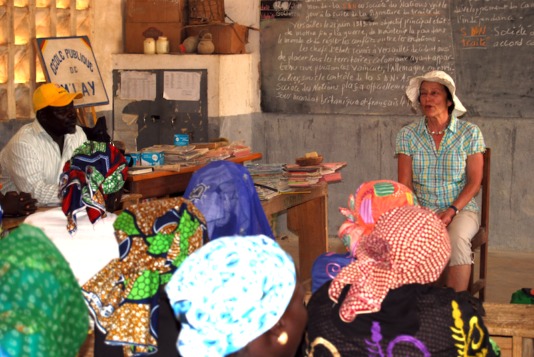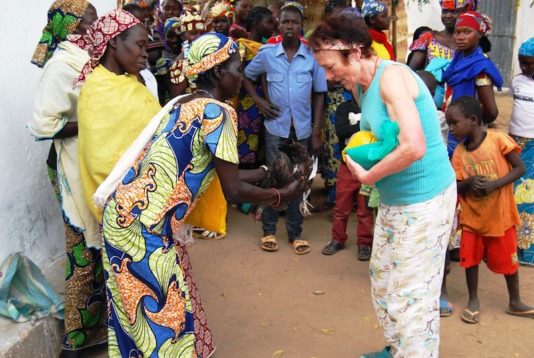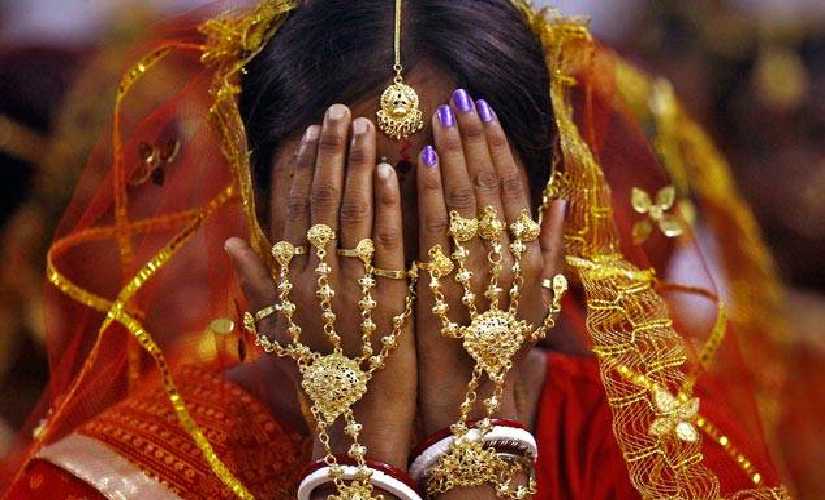- About
- Topics
- Picks
- Audio
- Story
- In-Depth
- Opinion
- News
- Donate
- Signup for our newsletterOur Editors' Best Picks.Send
Read, Debate: Engage.
| November 22, 2019 | |
|---|---|
| topic: | Women's rights |
| tags: | #women's rights, #human rights, #Africa, #Terre des Femmes, #breast ironing, #female genital mutilation |
| located: | Cameroon |
| by: | Frank Odenthal |
German ethnologist Prof. Godula Kosack is chairwoman of the non-governmental organisation "Terre Des Femmes", which takes care of women's rights worldwide. Here she explains the phenomenon of breast ironing.
FairPlanet: Unlike female genital mutilation, in which the clitoris is cut extremely painfully, breast ironing is barely known to a wider public. FairPlanet reported on it in 2017, but apparently little has changed. In your own words, could you explain what breast ironing is?
Prof. Godula Kosack: At the so-called "breast ironing", girls between the ages of 11 and 15, as soon as their breasts develop, are subject to a procedure that prevents the normal development of the breast. The "ironing" is done with stones, sticks and other things that are heated over a flame and then pressed onto the emerging chest or rolled over it. Then the breast is wrapped very tight. This partially destroys the breast tissue. The procedure is repeated daily or weekly for years.
What are the motives for breast ironing?
The goal of breast ironing is to keep the breasts of young girls flat and to give them a childlike appearance. Men should not feel sexual arousal at the sight of the girls’ breasts. This should protect them from rape and unwanted pregnancies. However, experience shows that those affected by breast ironing do not experience sexual violence less often.
Which social classes are particularly affected? Does religion matter?
Breast ironing, when it is practised, occurs in all social classes. In contrast to female genital mutilation, it has no ritual background, so it is not grounded in any religion, not even in traditional beliefs. Rather, it is believed that it is a derivation of the ancient ritual of “breast massage”, which is very common among African women, but which should make the breasts functional by manipulating the tissue – i.e. the opposite of stopping natural growth – and, as a side effect, to give them a more beautiful shape. The rapid spread of this intervention is due to the concern for the sexual integrity of the girls. At least that's what the mothers who torture their daughters this way intend. As a rule, the mothers and grandmothers perform the procedure. They want to protect their daughters. Rape of minors appears to have increased in recent decades as society becomes more urbanised and the traditional customs collapse.
What are the consequences – short and long term – for women affected by breast ironing?
Breast ironing is not only extremely painful, it also often results in burned connective tissue damages that are irreparable. The breasts become unbalanced, cysts develop, fever, skin injuries, in short: it destroys the breasts in whole or in part. The bandages the girls have to wear limit their freedom of movement. A psychological consequence is the inevitable rejection of one's own femininity. Where breast ironing is practised, girls who withdraw from the procedure are teased or even bullied about their developed breasts.
Which countries / regions are particularly affected?
Breast ironing is very common in Cameroon, especially in the coastal region and the grasslands, but you can also find it in countries like South Africa and Nigeria. It is estimated that 3 or 4 million young women are affected.
What can be done to help those women – after breast ironing, but also preventively?
The best help for all affected girls – obviously – is to stop the harmful practice immediately. Whether there are any means to restore destroyed connective tissue is questionable. Above all, a social rethink would be important. On the one hand, the dreaded sexual violence on the part of men must be severely punished, so that the fear of abuse becomes unfounded, on the other hand, it is important that young women can live a self-determined life, so that they are not already married as a minor and forced to motherhood. Fear of premature marriage may also cause many girls to "voluntarily" undergo this procedure.
During your professional and academic career, have you ever been confronted with the phenomenon of breast ironing? Can you tell us about it?
As an ethnologist I did some research in the north of Cameroon, at the Mafa people in the Mandara Mountains. There is neither genital mutilation nor "breast ironing" practised there. When I spoke to women about such practices, they found them just as strange as me.
In January 2019, the English newspaper The Guardian reported that breast ironing is spreading among young women even in the UK. How do you rate this tendency? What should be done to stop such practices in migrant milieus in Europe?
The Guardian report, which is based on a journalistic research, has brought the issue of "breast ironing" into the limelight in the UK. A similar investigation in Germany and other countries is pending. Here we can only operate very vaguely with dark figures, which can only be estimated from the number of possible victims in the country. There is no well-founded survey on that matter yet. It would be important to know whether the so-called custom in countries such as Great Britain or Germany, where gender equality is formally guaranteed in the constitution, diminishes, for example because the right to free development is exercised by all girls; or, on the other hand, serves as a custom that is elevated to an ethnic tradition to differentiate itself from the mainstream society and assert a supposed ethnic identity. This is partly the case with genital mutilation, which is resumed in families that have already said goodbye to this harmful practice in their countries of origin. Here the performers of that practice overlook or simply ignore that this is not a religious or traditional act, but rather a tribute to patriarchy. Mothers usually base this human rights violation on their daughters on the fact that the emerging sexual stimuli should not mislead men into abusing their daughters. That‘s where the education work in the communities should begin. Not the girls who are supposed to be protected should be hurt and defaced, but the men who exploit every opportunity to live out their sexual urges must be stopped. In Germany, genital mutilation is a stand-alone element of crime since 2013. Violation can result in up to 15 years in prison. This offence should be extended to "breast ironing". If the actors realise that they are committing an offence, they are forced to find other ways to protect their daughters. Their anger would then legitimately be directed at the harassing men. That could initiate a social change, a re-thinking process.
Terre des Femmes is very active in the fight against female genital mutilation. Are there comparable motives of genital mutilation and breast ironing?
Genital mutilation is much more common than breast ironing. According to UNICEF, more than 200 million women worldwide are affected by female genital mutilation. Religious or traditional ritual practices are usually cited as justification for this practice, but I have never heard of this with respect to breast ironing. Breast ironing is intended to protect the girls, genital mutilation should be understood as a rite of initiation in which the girls become women. Between the two practices, more differences than similarities in motivation can be listed. What they all have in common, however, is that in the interests of patriarchal structures, girls are harmed, damaged and even mutilated.
Is there any social resistance to breast ironing in the affected countries? Which organisations (or private persons) are fighting against breast ironing – on the ground or at an international level?
There are more and more educational campaigns in countries where breast ironing is practised. The Ministry of Health in Cameroon as well as the national and international press are increasingly reporting the suffering that many girls in Cameroon experience at the beginning of their sexual maturity. The Cameroonian non-governmental organisation RENATA, better known as "Tantines", friendly aunts, takes this issue into the schools. Their slogan is: "Do not iron breasts, they are a gift from God". I am not aware of such campaigns in other countries concerned, but I assume that they exist.
Will Terre des Femmes also campaign against breast ironing in the future?
Terre Des Femmes does not have the capacity to deal with all sorts of human rights violations against women and girls in the form of campaigns or projects. That is an overall social task. Terre Des Femmes is a non-profit association funded mainly through donations. At the moment, our mandate, as we see it, is to raise awareness of breast ironing in order to sensitise the professional groups that deal with potential victims, who in turn can shed light on this issue or initiate campaigns. Because of its experience with genital mutilation, Terre Des Femmes can provide quite a good basis for this type of education. But in order to achieve as much as possible, we need further financial support for our work.
Prof. Dr. Godula Kosack is CEO of Terre Des Femmes Germany. She is a sociologist and ethnologist. She has spent decades researching at Mafa people in North Cameroon, where she oversaw numerous projects. She is currently volunteer coordinator of the Terre Des Femmes project "Self-determination through education", which enables girls from Northern Cameroon to attend school and gain vocational training. She has published on women's issues (women in Africa, witch hunts, menopause, patriarchy and worldviews). Her commitment also applies to the fight against genital mutilation in Africa. She currently lives in Leipzig, Germany.
By copying the embed code below, you agree to adhere to our republishing guidelines.


